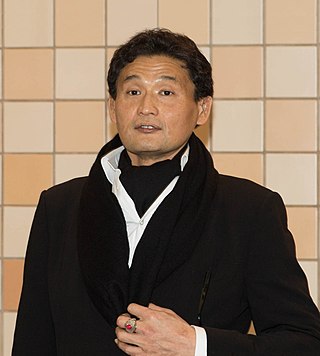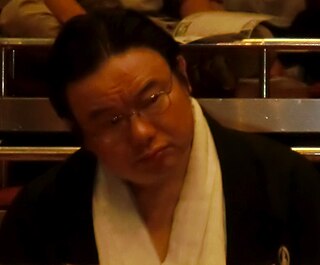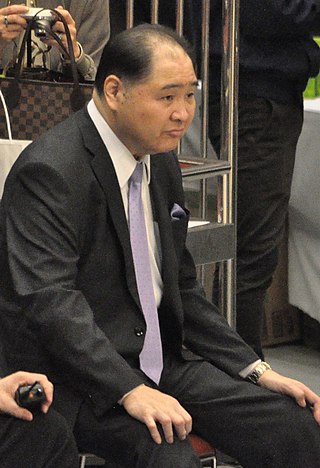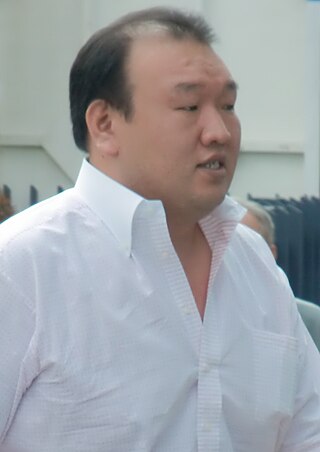Related Research Articles

Takanohana Kōji is a Japanese former professional sumo wrestler and coach. He was the 65th man in history to reach sumo's highest rank of yokozuna, and he won 22 tournament championships between 1992 and 2001, the sixth highest total ever. The son of a popular ōzeki ranked wrestler from the 1970s, Takanohana's rise through the ranks alongside his elder brother Wakanohana and his rivalry with the foreign born yokozuna Akebono saw interest in sumo and attendance at tournaments soar during the early 1990s.
The Japan Sumo Association, sometimes abbreviated JSA or NSK, is the body that operates and controls professional sumo wrestling in Japan under the jurisdiction of the Japanese Ministry of Education, Culture, Sports, Science and Technology (MEXT). This means concretely that the Association maintains and develops sumo traditions and integrity by holding tournaments and tours. The purposes of the Association are also to develop the means dedicated to the sport and maintain, manage and operate the facilities necessary for these activities. Therefore, the JSA operates subsidiaries such as the Kokugikan Service Company to organize its economic aspects, the Sumo School to organize training and instruction or the Sumo Museum to preserve and utilize sumo wrestling records and artifacts.

A toshiyori (年寄) is a sumo elder of the Japan Sumo Association (JSA). Also known as oyakata (親方), former wrestlers who reached a sufficiently high rank are the only people eligible. The benefits are considerable, as only toshiyori are allowed to run and coach in sumo stables, known as heya, and they are also the only former wrestlers given retirement pay.

Asahifuji Seiya is a Japanese former professional sumo wrestler from Aomori. He joined professional sumo in 1981, reaching the top makuuchi division just two years later. He reached the second highest rank of ōzeki in 1987 and became the 63rd yokozuna in the history of the sport in 1990 at the age of 30. He won four tournaments and was a runner-up on nine other occasions. He retired in 1992 and is now the head coach of Isegahama stable. As a coach he has produced two yokozuna Harumafuji and Terunofuji.
Wakanohana Kanji was a Japanese professional sumo wrestler from Ōwani, Aomori. He was the sport's 56th yokozuna. He was popular with sumo fans and was well-known for his rivalry with Kitanoumi. After retirement, he became the head coach of Magaki stable. Due to poor health, he left the Japan Sumo Association in December 2013. He died of lung cancer in July 2022 at the age of 69.

Sakahoko Nobushige was a Japanese sumo wrestler. The son of Tsurugamine, he made his professional debut in 1978, reaching the top makuuchi division in 1982. His highest rank was sekiwake. He won nine special prizes and seven gold stars for defeating yokozuna. He retired in 1992 and became the head coach of Izutsu stable in 1994, succeeding his father. He oversaw Kakuryū's promotion to the yokozuna rank in 2014 but also saw the size of his stable decline. He was a deputy director of the Japan Sumo Association and a judge of tournament bouts. He died of pancreatic cancer in 2019. He was the elder brother of fellow top division sumo wrestler Terao Tsunefumi.

Kotokaze Kōki is a former sumo wrestler from Tsu, Mie, Japan. Beginning his career in 1971, he reached the top makuuchi division in 1977 but after a serious injury in 1979 he fell greatly in rank before staging a comeback. His highest rank was ōzeki, which he reached in 1981. He won two tournament championships and was a runner-up in two others. He won six special prizes and six gold stars for defeating yokozuna. He retired in 1985 and became an elder of the Japan Sumo Association and the head coach of Oguruma stable.
Hasegawa Katsutoshi is a former sumo wrestler from Kurisawa, Hokkaido, Japan. He began his professional career in 1960, reaching the top division in 1965. He won eight special prizes for his achievements in tournaments and earned nine gold stars for defeating yokozuna. He won a tournament championship or yūshō in 1972 and was a runner-up in two other tournaments. His highest rank was sekiwake. He retired in 1976 and became an elder of the Japan Sumo Association, working as a coach at Sadogatake stable until his retirement in 2009.

Asanowaka Takehiko is a former sumo wrestler from Ichinomiya, Aichi Prefecture, Japan. His highest rank was maegashira 1. He is now a sumo coach.
Ryōgoku Kajinosuke IV is a former sumo wrestler from Nagasaki, Japan. His highest rank was komusubi. He is now a sumo coach under the name of Sakaigawa.
Fujinokawa Takeo is a former sumo wrestler from Otofuke, Hokkaido, Japan. He made his professional debut in May 1961 and reached a highest rank of sekiwake in May 1967. He was a runner-up in two top division (makuuchi) tournaments, finishing three wins behind Tamanoshima in May 1968 and losing a playoff to ozeki Kiyokuni in July 1969. He earned four kinboshi for defeating yokozuna and won seven special prizes. After his retirement in 1972 at the age of 26 he became an elder of the Japan Sumo Association and took over as head coach of Isenoumi stable in 1982. He left the Sumo Association in 2011 upon reaching 65 years of age.
Kaiki Nobuhide is a former sumo wrestler from Tenmabayashi, Aomori, Japan. He made his professional debut in 1965, and was promoted to the top makuuchi division in 1975. He earned three gold stars for defeating yokozuna and one special prize. His highest rank was sekiwake, which he reached in July 1979. He retired in 1987 and was the head coach of the Tomozuna stable from 1989 until 2017, training ōzeki Kaiō among others. He was also a Director of the Japan Sumo Association. In 2017 he was re-hired by the Sumo Association as a consultant after retiring as head coach.

Kōbōyama Daizō is a former sumo wrestler from Tsukidate, Kurihara, Miyagi Prefecture, Japan. He made his professional debut in 1973 and reached the top makuuchi division in 1981. His highest rank was sekiwake. He earned two special prizes for Technique and was a runner-up in one tournament. He retired in 1990. He is now a sumo coach and ran the Takashima stable from 1993 until 2011. He was elected to the Japan Sumo Association's board of directors in 2018.
The following are the events in professional sumo during 2011.
Kitakachidoki Hayato is a former sumo wrestler from Obihiro, Hokkaidō, Japan. He made his professional debut in 1981, and reached the top division in 1989. His highest rank was maegashira 3. After retirement he became an elder in the Japan Sumo Association. He took over as head coach at Isenoumi stable, when former head coach Fujinokawa reached mandatory retirement age in September 2011.
Ōnishiki Ittetsu is a former sumo wrestler from Sado, Niigata, Japan. He made his professional debut in May 1968, and reached the top division in September 1973. His highest rank was komusubi. He retired in January 1988 and became an elder in the Japan Sumo Association under the name Yamashina, holding the Special Executive position.

Ganyū Kenji is a former sumo wrestler from Himeji, Hyōgo, Japan. He made his professional debut in March 1986, and reached the top division in March 1996. His highest rank was maegashira 1. He retired in 2000 and became an elder of the Japan Sumo Association. In 2015 he became the head coach of Yamahibiki stable following the death of his old stablemaster, Kitanoumi.
Sasshūnada Yasutaka is a former sumo wrestler from Ibusuki, Kagoshima, Japan. He made his professional debut in January 1976, and reached the top division in September 1986. His highest rank was maegashira 1. He retired in September 1992. As of 2023 he is an elder in the Japan Sumo Association under the name Tatsutayama.
The following are the events in professional sumo during 2021.
References
- ↑ "Sumo World Magazine". Sumo World. July 1993. p. 30. Retrieved 6 September 2022.
- ↑ "Oyakata (Coaches)". Nihon Sumo Kyokai. Retrieved 6 September 2022.
- ↑ "Why is Michinoku a director and Kokonoe a special executive? Deciphering the duties of the elders of the Japan Sumo Association". Nikkan Sports. 6 April 2022. Retrieved 6 September 2022.
- ↑ "Kototsubaki Katsuyuki Rikishi Information". Sumo Reference. Retrieved 3 September 2012.